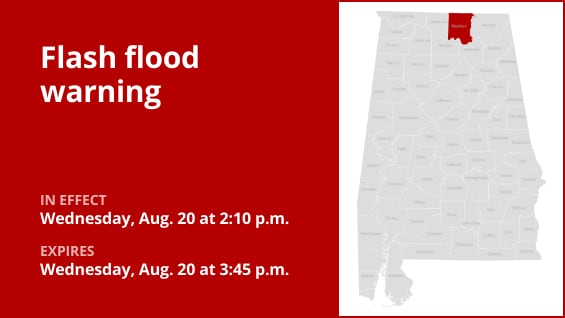The National Weather Service issued a flash flood warning for Madison County on Wednesday at 2:10 p.m., which was in force until 3:45 p.m.
“Doppler radar showed thunderstorms causing heavy rain in the notified area at 2:10 p.m. There has been one to two inches of rain. Two to three inches of rain are predicted to fall in an hour. The cautioned area may see an additional 1 to 2 inches of rainfall. According to the weather service, flash flooding is either already occurring or is predicted to start soon. “Flash flooding of small creeks and streams, urban areas, highways, streets and underpasses as well as other poor drainage and low-lying areas.”
Redstone Arsenal, Huntsville, Madison, Moores Mill, Triana, Marshall Space Flight Center, University of Alabama in Huntsville, Alabama A and M University, Huntsville International Airport, Farley, and Whitesburg are among the places affected by the warning.
When you come across flooded roads, the weather service advises you to turn around and avoid drowning. Vehicles are the primary cause of flood fatalities. Avoid driving on flooded roads and pay attention to your surroundings.
Breaking down weather alerts: advisories, watches, and warnings
-
Flash flood warning: Take action!
When a flash flood is approaching or already happening, a warning is sent. Get to high ground right away if you’re in a flood-prone location. A flash flood is a quick, intense flood that can form in a matter of minutes to hours. Even in places that don’t get rain right away, flash floods can happen.
-
Flood warning: Take action!
When flooding is expected or is happening, a flood warning is issued.
-
Flood advisory: Be aware:
When flooding is not predicted to be severe enough to warrant a warning, a flood advisory is issued. But if care is not taken, it could result in circumstances that endanger life and/or property and cause a great deal of discomfort.
-
Flood watch: Be prepared:
When the weather is conducive to flooding, a flood watch is issued. Although it doesn’t ensure flooding will happen, it does indicate that it is a potential.
When floods strike: Guidelines from the weather service for your protection
Floods can be a serious hazard, particularly if you live in a flood-prone location or camp in a low-lying area. The weather service provides crucial flood protection instructions to protect you:
Look for higher ground.
Moving to higher ground should be your first course of action if you’re camping in a low-lying location or in an area that is prone to flooding.
Observe evacuation directives:
Respond quickly to any evacuation orders issued by local authorities. Secure your home by locking it before you leave.
Cut off appliances and utilities:
Disconnect your appliances and utilities if you have the time. By taking this precaution, electrical dangers during flooding are reduced.
Avoid drowned places and flooding basements:
Avoid basements or rooms with electrical outlets or cords submerged in water. This lessens the chance of electrical mishaps.
Quickly leave for your safety:
Evacuate right away if you see sparks or hear popping, crackling, buzzing, or snapping sounds. Steer clear of any water that might be electrically charged.
Avoid the floodwaters:
Even if floodwaters seem shallow, you should never try to go over them. You can be swept off your feet with power by just 6 inches of swift-moving water.
If you’re stuck, look for high ground:
If you find yourself caught by flowing water, move to the highest spot you can and dial 911 to reach rescue personnel.
floods is more likely during periods of high rainfall, particularly in areas that are low-lying and prone to floods. No matter how shallow the water looks, you should never drive through it. The weather service claims that most cars can be washed away by as little as 12 inches of swiftly moving water. Be knowledgeable and ready to be safe.
Mastering wet roads: Safety tips for heavy rainfall
If heavy rainfall persists or if runoff is substantial, flooding may result. Saturated soils and/or heavy rainfall can cause excessive runoff. To keep safe during periods of intense rain, heed these weather service recommendations:
Watch out for flooding rivers:
When it rains a lot, stay clear from parking or strolling near culverts or drainage ditches since the swift-moving water could carry you away.
Keep your distances from other vehicles safe:
Keep a safe distance from the automobile ahead of you by following the two-second rule, and give yourself an extra two seconds if it’s raining a lot.
Reduce your speed and exercise caution:
Lowering your speed is essential on wet roads. To prevent skidding, reduce the accelerator gradually rather than braking suddenly.
Pick your lane carefully:
To reduce the chance of hydroplaning, stay in the middle lanes. Water is more likely to accumulate in outside lanes.
Visibility is important.
As rain-spattered windows make it more difficult to see other vehicles, turn on your headlights and pay attention to those in blind spots and behind you.
Be cautious on slick roads:
Because of a combination of rain, oil, and grime, roadways are at their slickest during the first 30 minutes of precipitation. Be especially careful during this time.
Stay a safe distance away from big cars:
Avoid following buses or big vehicles too closely. Their big tires produce a mist that blurs your eyesight. Additionally, if you have to pass them, proceed with caution.
Be mindful of your wipers:
-
Heavy rain can overload the wiper blades. When visibility is so limited that the edges of the road or other vehicles cannot be seen at a safe distance, it is time to pull over and wait for the rain to ease up. It is best to stop at rest areas or other protected areas.
-
If the roadside is your only option, pull off as far as possible, preferably past the end of a guard rail, and wait until the storm passes. Keep your headlights on and turn on emergency flashers to alert other drivers of your position.
Taking these safety measures will significantly improve your road safety while it’s raining a lot. For a safe trip, keep yourself updated on weather conditions and follow local authorities’ instructions.
United Robots offers a service called Advance Local Weather Alerts that gathers the most recent information from the National Weather Service using machine learning.






